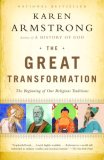Summary | Excerpt | Reading Guide | Reviews | Beyond the Book | Readalikes | Genres & Themes | Author Bio

The Beginning of Our Religious Traditions
by Karen ArmstrongContents
List of Maps and Plans
Acknowledgments
Introduction
1. THE AXIAL PEOPLES (c. 1600 to 900 bce)
2. RITUAL (c. 900 to 800 bce)
3. KENOSIS (c. 800 to 700 bce)
4. KNOWLEDGE (c. 700 to 600 bce)
5. SUFFERING (c. 600 to 530 bce)
6. EMPATHY (c. 530 to 450 bce)
7. CONCERN FOR EVERYBODY (c. 450 to 398 bce)
8. ALL IS ONE (c. 400 to 300 bce)
9. EMPIRE (c. 300 to 220 bce)
10. THE WAY FORWARD
Notes
Glossary
Bibliography
Index
ASRA
THE AXIAL PEOPLES
(c. 1600 to 900 BCE)
The first people to attempt an Axial Age spirituality were
pastoralists living on the steppes of southern Russia, who
called themselves the Aryans. The Aryans were not a distinct
ethnic group, so this was not a racial term but an assertion
of pride and meant something like "noble" or "honorable."
The Aryans were a loose-knit network of tribes who shared a
common culture. Because they spoke a language that would
form the basis of several Asiatic and European tongues, they
are also called Indo-Europeans. They had lived on the
Caucasian steppes since about 4500, but by the middle of the
third millennium some tribes began to roam farther and
farther afield, until they reached what is now Greece,
Italy, Scandinavia, and Germany. At the same time, those
Aryans who had remained behind on the steppes gradually
drifted apart and became two separate peoples, speaking
different forms of the original Indo-European. One used the
Avestan dialect, the other an early form of Sanskrit. They
were able to maintain contact, however, because at this
stage their languages were still very similar, and until
about 1500 they continued to live peacefully together,
sharing the same cultural and religious traditions.
It was a quiet, sedentary existence. The Aryans could not
travel far, because the horse had not yet been domesticated,
so their horizons were bounded by the steppes. They farmed
their land, herded their sheep, goats, and pigs, and valued
stability and continuity. They were not a warlike people,
since, apart from a few skirmishes with one another or with
rival groups, they had no enemies and no ambition to conquer
new territory. Their religion was simple and peaceful. Like
other ancient peoples, the Aryans experienced an invisible
force within themselves and in everything that they saw,
heard, and touched. Storms, winds, trees, and rivers were
not impersonal, mindless phenomena. The Aryans felt an
affinity with them, and revered them as divine. Humans,
deities, animals, plants, and the forces of nature were all
manifestations of the same divine "spirit," which the
Avestans called mainyu and the Sanskrit-speakers
manya. It animated, sustained, and bound them all
together.
Over time the Aryans developed a more formal pantheon. At a
very early stage, they had worshiped a Sky God called Dyaus
Pitr, creator of the world. But like other High Gods, Dyaus
was so remote that he was eventually replaced by more
accessible gods, who were wholly identified with natural and
cosmic forces. Varuna preserved the order of the universe;
Mithra was the god of storm, thunder, and life-giving rain;
Mazda, lord of justice and wisdom, was linked with the sun
and stars; and Indra, a divine warrior, had fought a
three-headed dragon called Vritra and brought order out of
chaos. Fire, which was crucial to civilized society, was
also a god and the Aryans called him Agni. Agni was not
simply the divine patron of fire; he was the fire that
burned in every single hearth. Even the hallucinogenic plant
that inspired the Aryan poets was a god, called Haoma in
Avestan and Soma in Sanskrit: he was a divine priest who
protected the people from famine and looked after their
cattle.
Excerpted from The Great Transformation by Karen Armstrong Copyright © 2006 by Karen Armstrong. Excerpted by permission of Knopf, a division of Random House, Inc. All rights reserved. No part of this excerpt may be reproduced or reprinted without permission in writing from the publisher.






Your guide toexceptional books
BookBrowse seeks out and recommends the best in contemporary fiction and nonfiction—books that not only engage and entertain but also deepen our understanding of ourselves and the world around us.